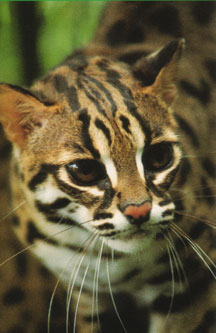|
Animal Spotlight
September 2002
Origin of the Bengal Cat One fine day during the 1970s, a man called Dr. Willard Centerwall was doing a Feline Leukemia research at Loyola University, USA. He knew that a particular small and relatively unknown species of Asian wild cat was somehow immune to feline Leukemia, so he and his team of researchers used these cats to seek a cure for Leukemia in felines, in other species and in humans. The team cross bred these little wild cats with domestic cats to study the differences in the resulting offspring. Since then, the National Institution of Health (NIH) has been and is still utilizing the early generation of these hybrids in their Feline Leukemia research. The work done in the research has been of a tremendous help in human medical research, in which new techniques are being devised to 'cure' similar diseases in humans. Many breeders of the first generation of these hybrids (called F1) are still contributing blood samples from their F1 hybrids for this research. Then in the early 1980's, Dr. Centerwall became ill. A lady named Jean Mill obtained several F1 hybrid cats from him. These hybrid cats went on to become some of the first domestic Bengal Cats and most Bengal Cats today can be traced back to these F1 specimens. Jean Mill once said that her reason for breeding Bengal Cats was to put the coat of a leopard on that of a domestic cat in an effort to stop the sales of fur coats. She felt this would make it hard to sell fur coats that looked like those of pets, and would hence help to stop the trapping and killing of these animals in the wild. Bengal Cats are said to be one of the healthiest and most intelligent of all breeds of domestic cats and are very prolific. Many breeders that breed Bengal Cats today, do so because of all the health and breeding problems they have had in the past with other breeds of cats. Bengal Cats may also hold the key to the future health of all breeds of cats by contribution of new genes to other domestic cats if ever needed. So which is that Asian wild cat that helped to create this unique new breed of domestic Bengal Cat? The answer is revealed below...... P.S. To avoid further infringing the copyrights of others on this webpage, please refer to the official Bengal Cat websites listed at the bottom of this page to read more detailed information and view their photos. The above edited passages were obtained from The International Bengal Breeders' Association, Inc. website.
For further information about the Leopard Cat and other Small Wild Cats, check out this great website that is dedicated to these fantastic felines ! Plus this website 'Leopard Cat' - http://lynx.uio.no/catfolk/bengal01.htm and also check out The Cat Survival Trust, Leopard Cat - http://members.aol.com/cattrust/lepcat.htm
If you require more information about the unbelievable Bengal Cat, you can read all about them at the following websites dedicated to this unique breed: bengalcat.co.uk - http://www.bengalcat.co.uk/ The International Bengal Breeders' Association, Inc.- http://tibba.8k.com/index.html
Acknowledgements / Bibliography - Facts from Wildlife Fact File and the above listed websites, Photo from Night Safari.
Back to
Home | Explore | Rangers’ Station | Walking Trails | Tram Ride | Resources
|
|||||||


